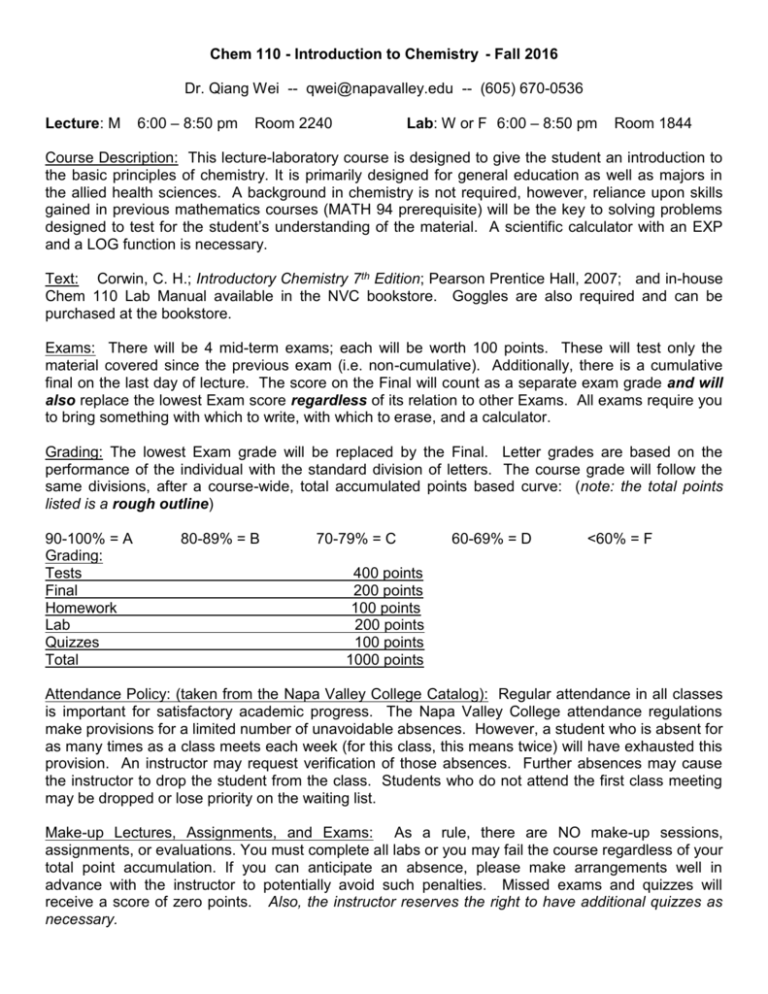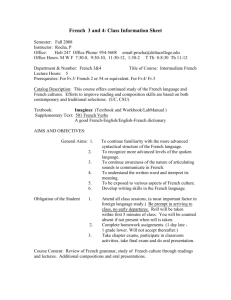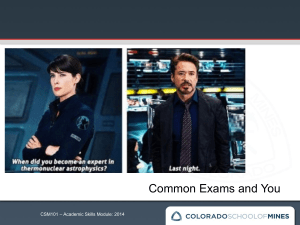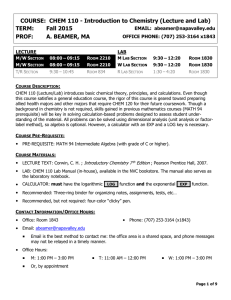
Chem 110 - Introduction to Chemistry - Fall 2016
Dr. Qiang Wei -- qwei@napavalley.edu -- (605) 670-0536
Lecture: M
6:00 – 8:50 pm
Lab: W or F 6:00 – 8:50 pm
Room 2240
Room 1844
Course Description: This lecture-laboratory course is designed to give the student an introduction to
the basic principles of chemistry. It is primarily designed for general education as well as majors in
the allied health sciences. A background in chemistry is not required, however, reliance upon skills
gained in previous mathematics courses (MATH 94 prerequisite) will be the key to solving problems
designed to test for the student’s understanding of the material. A scientific calculator with an EXP
and a LOG function is necessary.
Text: Corwin, C. H.; Introductory Chemistry 7th Edition; Pearson Prentice Hall, 2007; and in-house
Chem 110 Lab Manual available in the NVC bookstore. Goggles are also required and can be
purchased at the bookstore.
Exams: There will be 4 mid-term exams; each will be worth 100 points. These will test only the
material covered since the previous exam (i.e. non-cumulative). Additionally, there is a cumulative
final on the last day of lecture. The score on the Final will count as a separate exam grade and will
also replace the lowest Exam score regardless of its relation to other Exams. All exams require you
to bring something with which to write, with which to erase, and a calculator.
Grading: The lowest Exam grade will be replaced by the Final. Letter grades are based on the
performance of the individual with the standard division of letters. The course grade will follow the
same divisions, after a course-wide, total accumulated points based curve: (note: the total points
listed is a rough outline)
90-100% = A
Grading:
Tests
Final
Homework
Lab
Quizzes
Total
80-89% = B
70-79% = C
60-69% = D
<60% = F
400 points
200 points
100 points
200 points
100 points
1000 points
Attendance Policy: (taken from the Napa Valley College Catalog): Regular attendance in all classes
is important for satisfactory academic progress. The Napa Valley College attendance regulations
make provisions for a limited number of unavoidable absences. However, a student who is absent for
as many times as a class meets each week (for this class, this means twice) will have exhausted this
provision. An instructor may request verification of those absences. Further absences may cause
the instructor to drop the student from the class. Students who do not attend the first class meeting
may be dropped or lose priority on the waiting list.
Make-up Lectures, Assignments, and Exams: As a rule, there are NO make-up sessions,
assignments, or evaluations. You must complete all labs or you may fail the course regardless of your
total point accumulation. If you can anticipate an absence, please make arrangements well in
advance with the instructor to potentially avoid such penalties. Missed exams and quizzes will
receive a score of zero points. Also, the instructor reserves the right to have additional quizzes as
necessary.
Homework: The homework is listed in the syllabus and each section is worth 5 points each. Every
prompt must be written out and all work will be shown in order to receive credit. Homework is an allor-nothing affair. Partial completion receives zero points. It is in your best interest to do the
homework fully, and with great fervor, as it will directly aid you in succeeding in this course.
Electronic Devices: Cell phones, etc. are to be turned OFF before lecture and/or lab begins.
Electronic means of recording the lectures are not permitted (this includes both audio and video
recording) unless otherwise cleared with the professor. Additionally, laptop computers should be
stored during lectures; take notes the old-fashioned way (with paper and pen). Cell phones are NOT
to be used as calculators during exams. Additionally, ipods, and the like, are also banned from
lectures and labs.
Laboratory Requirements: You are expected to be prepared for lab BEFORE starting the experiment.
You may not begin the experiment unless you have met a set of minimum, but mandatory,
requirements. These requirements include that you 1) have a completed pre-laboratory assignment
from the lab manual, 2) attend the pre-lab lecture, and 3) be properly protected by wearing safety
glasses, close-toed shoes, and clothing that completely covers from the shoulders to the knees.
Failure to meet these minimum requirements may prevent you from participating in that lab session.
If you arrive after the START of the pre-lab lecture, you have missed it and points will be deducted, as
well as not gaining the wisdom of lab hints and techniques. This is not advised. Failure to wear safety
glasses while the instructor is wearing his will result in being immediately ejected from that day’s
session without the possibility of being readmitted. All labs are to be turned in at the end of lab on the
same day that they are performed unless otherwise stated. Labs will be performed individually and all
work must be your own. You must complete all labs.
Letters of Accommodation:
Any student who feels s/he may need an accommodation based on the impact of a learning disability
should contact Learning Services in the Library and Learning Resource Center (LLRC), room 1766,
phone (707) 256-7442. A Learning Disability Specialist will review your needs and determine
appropriate accommodations.
If you need accommodations for physical or other types of disabilities, schedule an appointment with
DSPS Counselor, Sheryl Fernandez, in the Counseling Department located in the 1300 building,
phone (707) 256-7220 for appointment.
All information and documentation is confidential. Please feel encouraged to make an appointment
with me privately to discuss your specific learning needs in my class. I am here to help you succeed.
Obligatory Statement of Academic Fraud (aka Cheating): All work must be of your own original
composition. Plagiarism from any source (books, papers, fellow classmates, Internet, etc.) or
unethical behavior during exams (notes, a neighboring exam, communication in any form, etc.) will
not be tolerated. The fabrication or use of data other than your own in the laboratory reports is
considered fraud. A failing grade will be assigned for that assignment. In addition, the matter will be
turned over to the Vice President of Student Services for further judiciary and disciplinary actions.
Consult your student handbook for additional information on this and other Honor Code stipulations.
Consider this statement as your first, last, and only warning regarding this matter.
Instructor: The best way to get in touch with the instructor is by email (fquinlan@napavalley.edu).
Because the office is shared, email is the only way that is guaranteed to get your message delivered.
The office is located in room 1843.
Tentative Schedule
Week
Dates
Day
1
1/18
M
W/F
2
3
4
5
6
7
1/25
2/1
2/8
2/15
2/22
2/29
Chpt
M
W/F
1
M
W/F
2,3
M
W/F
3
M
W/F
4
M
W/F
EXAM1,5
M
W/F
5,6
M
W/F
12
9
3/14
M
W/F
EXAM2, 13
3/21
M
W/F
11
3/28
M
W/F
13,7
12
4/4
M
W/F
7,8
13
4/11
M
W/F
9
M
W/F
EXAM 3,10
M
W/F
14
4/25
16
5/2
M
W/F
15
17
5/9
M
W/F
11
18
5/16
M
W/F
5/23
M
Measurement
Conversions
Expt 1
Measuring
Expt 2
Density
Expt 3
Q&A
Q&A
Matter
Expt 4
Light
Bonding
Expt 11
Models
IMFs
Q&A
Q&A
Expt 5
Periodic
Nature
Naming
Reactions
Expt 6
Rxns
Mass-Mass
Expt 9
Baking soda
Expt 12
Solutions
Expt 13
Titrations
Expt 13
Titrations
Expt 10
Ideal Gases
Q&A
Q&A
Check
Out
Check Out
Matter
Holiday
Light
Holiday
Holiday
10
15
Desciption
Check in to Lab/Course info
Intro and history
3/7
4/18
Lab
HOLIDAY
8
14
Lecture
solutions
Acid/Base
Gases
EXAM4,17
Final
E-Chem
Exam
Homework - 7th Edition Book
Chapter 1: 9
Chapter PSS: 7, 9, 11, 13, 15, 17, 19, 21, 23, 25, 31, 33, 37, 39, 45
Chapter 2: 1, 3, 9, 15, 16, 17, 18, 21, 22, 23, 25, 27, 29, 31, 35, 37, 39, 41, 43, 53, 55, 59, 61, 63, 65,
83
Chapter 3: 7, 8, 13, 15, 17, 18, 19, 20, 21, 22, 23, 24, 25, 27, 29 ,33, 35, 37, 39, 43, 47, 49, 53, 55,
59, 61
Chapter 4: 17, 19, 21, 22, 29, 33, 34, 35, 36, 37, 38, 39, 40, 41, 42, 43, 44, 53, 67, 69, 75, 76, 77, 78
Chapter 5: 9, 10, 11, 12, 17, 18, 19, 21, 22, 23, 24, 29, 30, 31, 32, 33, 34, 35, 36, 37, 38, 41, 42,
47, 49, 53, 54, 55, 56, 57, 59, 61, 62, 67, 71, 72, 73, 74, 77, 79
Chapter 12: 1-6, 11-18, 23, 29, 31, 33-36, 39, 49, 51, 55
Chapter 11: 11, 12, 13, 17, 18, 33, 34
Chapter 6: 1, 2, 5-8, 15-24, 25, 27, 29, 31, 33, 35, 39, 40, 50, 51, 53 , 55
Chapter 7: 7, 9, 11, 17-20, 27, 29, 33, 35, 37, 39, 41, 43, 45, 47, 49, 53, 55, 61-65, 67, 69, 71-74, 75,
77
Chapter 8: 15, 16, 41, 43, 47, 53, 59, 61, 67
Chapter 9: 7, 9, 19-28, 59-66, 75, 76
Chapter 13: 1, 2, 7-12, 15-18, 23, 25, 26, 27, 29, 35, 37, 43, 45, 47, 53, 54, 57-62, 65, 67, 69, 70
Chapter 14: 5-8, 11, 15-17, 27-39, 45-54, 61, 62, 65, 67, 73, 75
Chapter 10: 5-12, 17-20, 23-26, 29-32, 35, 36, 37, 41, 42, 43, 45, 47, 49
Student Learning Outcomes:
Describe chemical and physical processes at the molecular level and how they relate to the
macroscopic environment.
Solve both qualitative and quantitative chemistry problems while demonstrating the reasoning clearly
and completely.
Implement laboratory techniques correctly using appropriate safety procedures and express them
clearly in written laboratory reports.
Course Objectives: Upon completion of this course, the student will be able to:
• Perform basic chemically-related mathematical computations, including conversions within the
metric system, conversions between English and metric systems, density, temperature conversion,
gas laws, exponents, dimensional analysis and proportions, and mole-related problems, including
concentration of solutions.
• Define and appropriately use the terms atom, ion, charge, atomic number, mass number, atomic
mass, isotope, energy states, element, compound, mixture, solution, molecule, and formula unit.
• Create drawings to explain ionic bonding and covalent bonding, including coordinate covalent
bonding.
• Explain the organization and structure of the Periodic Table.
• Write ionic and covalent formulas, and name simple ionic and covalent compounds and acids; draw
the Lewis (electron dot and dash) structures of simple covalent compounds, including skeletal
structures.
• Explain polar using the concept of electronegativity to covalent bonds; determine oxidation numbers
and identify oxidation and reduction processes and their agents.
• Explain hydrogen bonding and dissolving.
• Use the terms salts, strong and weak bases, strong and weak acids, hydronium ion, ionize and
dissociate.
• Explain neutralization and bases as proton acceptors.
• Classify chemical equations, and write balanced chemical equations given only the reactants.
• Apply the mole concept, and perform mole-equation computations for gas-volume and non-gasvolume problems; calculate mole amounts, molar volumes, and molar masses; determine gas
densities from formula masses.
• Contrast the meanings of "concentrated and dilute" with "strong and weak;" calculate molar
concentrations (molarity) and normality.
• Apply the concept of pH and the factors that influence it.
• Work in a laboratory setting utilizing appropriate safety and technique procedures and standard
laboratory equipment.
• Perform a variety of experiments following laboratory directions.
• Develop and test hypotheses, gather and weigh evidence, and make appropriate conclusions.
LABORATORY SAFETY RULES
Your participation in this laboratory requires that you follow safe laboratory practices. You are
required to adhere to the safety guidelines listed below, as well as any other safety procedures given
by your instructor(s) in charge of the course. You will be asked to sign a form certifying that you were
informed of the safety guidelines and emergency procedures for this laboratory. Violations of these
rules are grounds for expulsion from the laboratory.
You have the right to ask questions regarding your safety in this laboratory, either directly or
anonymously, without fear of reprisal.
Goggles must be worn at all times while in lab. You must purchase a pair of goggle for yourself
and you may store them in your locker.
Long hair must be tied up in a bun during lab work. Loose long sleeves should be avoided in the
lab.
Shoes must be worn in the laboratory. These shoes must fully enclose your foot.
Locate the emergency evacuation plan posted by the door. Know your exit routes!
Locate emergency shower, eyewash station, fire extinguisher, fire alarm, and fire blanket.
Dispose of all broken glassware in the proper receptacle. Never put broken glass in the trashcan.
Notify you instructor immediately if you are injured in the laboratory; no matter how slight.
If any reagents are spilled, notify your instructor at once.
Never pipette fluids by mouth. Check odors cautiously (i.e. wafting). Never taste a chemical.
Eating or drinking in the lab is prohibited. Do not drink from the laboratory taps.
Children and pets are not allowed in the laboratory.
Wash your hands before and after working in the lab.
Turn off the Bunsen burner when you are not using it.
Every chemical in a laboratory must be properly labeled. If a label is unclear, notify your instructor.
Follow the instructor’s directions for disposal of chemicals.
Only perform the assigned experiment. No unauthorized experiments are allowed.
Use the proper instrument (eye-dropper, scoopula, etc.) to remove reagents from bottles. Never
return unused chemicals to the original container. Do not cross contaminate reagents by using the
same instrument for 2 different reagents. Never obtain reagents directly from stock solutions.
Material Safety Data Sheets (MSDS) are available for your reference. These contain all known health
hazards of the chemicals used in this course. In addition, there is information concerning protocols
for accidental exposure to the chemical. You are advised to inspect this binder







